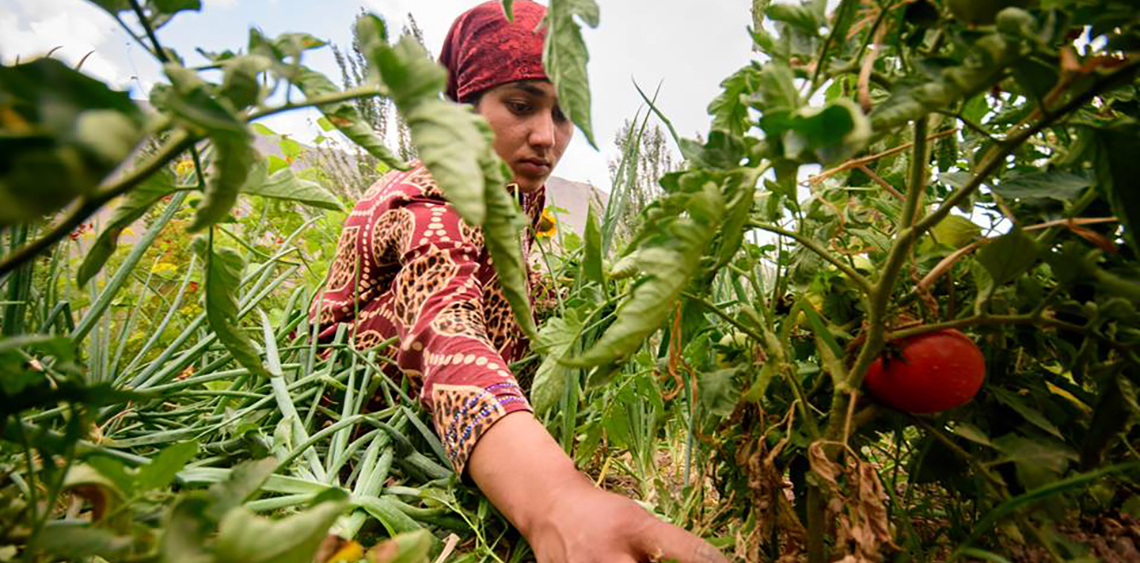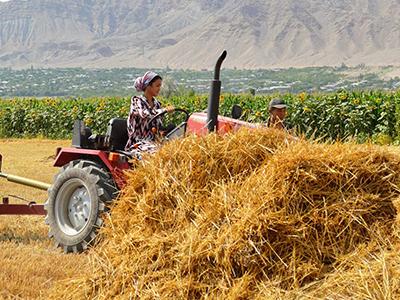
The Republic of Tajikistan is the most climate-vulnerable country in Central Asia: while extreme rainfall events have become more frequent and intense, the rainfall season has shortened in many parts of the country, air temperatures have risen markedly, and glacial melting is accelerating.
As a result, hydrometeorological disasters such as droughts, floods, mudflows and landslides are more frequent and rates of soil erosion across the country are increasing. The socio-economic impacts of these changes on livelihoods, agricultural productivity, water availability and hydroelectricity production are considerable.
Ageing infrastructure, the disproportionate number of women in poverty compared with men, and limited institutional capacity are exacerbating Tajikistan’s vulnerability to climate change and capacity to adapt.
This five-year project (2019 - 2024) will introduce an integrated approach to landscape management to develop the climate resilience of rural communities. The project will focus within one of the most climate-vulnerable river basins, the Kofirnighan River Basin. An integrated catchment management strategy will be developed for the basin which and implemented at raion (district), jamoat (sub-district) and village levels. The strategy will include guidelines for landscape management interventions to reduce the vulnerability to climate change.
- Regional
- Country Office
- Local Governments
- National Governments
- Non-Governmental Organizations
- Private Sector Partners
- United Nations Development Programme (UNDP)
46,000 people are expected to directly benefit from the project with another 828,000 to indirectly benefit, with at least 50% women.
- Committee for Environmental Protection, Tajikistan
- United Nations Development Programme (UNDP)
- Adaptation Fund
Background
Tajikistan has experienced a considerable warming of its climate since 1950. From 2001 to 2010, the country experienced the warmest decade in its history. Average temperatures in Tajikistan are projected to increase by 2.9°C by 2050.
The temperature changes have been accompanied by increasingly erratic rainfall which has resulted in both an increase in rainfall intensity and longer dry spells. In the major crop-growing regions, droughts that impact yields by at least 20% have been increasing in frequency over the past decade.
Tajikistan’s vulnerability to climate change is attributable to weak social structures; low adaptive capacity; underdeveloped infrastructure; low-income insecurity; poor service provision; strong dependence on agriculture; and institutional constraints. Losses from natural hazards currently amount to ~20% of the country’s GDP and climate change impacts are predicted to increase the frequency and magnitude of such losses.
These climatic changes will have negative impacts on climate-sensitive sectors, including agriculture, water, energy and transport. For example, a decrease in dry‑season water availability will adversely affect the agricultural sector, which in turn increases the risk of food insecurity in the country.
About the project
This project will introduce an integrated approach to landscape management to develop the climate resilience of rural communities.
The project will focus within the Kofirnighan River Basin, identified by the State Agency for Hydrometeorology (Hydromet) as a basin particularly vulnerable to extreme climate events.
The project focuses its activities within this basin due to limited international support for the implementation of integrated catchment management; a large number of communities within the basin are highly vulnerable to a wide range of climate risks; the basin’s variable topographic and climatic conditions are highly representative of the conditions in Tajikistan; and there are no transboundary disputes along the river. The districts were deemed the most vulnerable: Vakhdat, Faizobod and Varzob in the north; and ii) Nosiri Khusrav, Kabodiyon and Shaartuz in the south.
An integrated catchment management strategy will be developed for this basin which will be operationalised at raion (district), jamoat (sub‑district) and village levels. The strategy will provide detailed guidelines for suitable landscape management interventions to reduce the vulnerability to climate change.
Complementing the catchment management strategy, the project will directly build the resilience of selected communities by:
i) implementing on‑the‑ground ecosystem-based adaptation (EbA);
ii) supporting agro-ecological extension services to provide technical assistance on climate change adaptation practices to local community members;
iii) promoting the development of business models that capitalise on EbA interventions; and
iv) developing a Payment for Ecosystem Services approach to support the long‑term financing of climate‑resilient catchment management plans across Tajikistan.
A wide range of stakeholders were consulted during the scoping and validation of the project development.
For more information, please refer to the Project Document here.
Component 1: Integrated catchment management to build climate resilience
Expected outcome: Catchment management strategy to manage climate risks operationalised at raion (district) and jamoat (sub- district) levels in Kofirnighan River Basin (KRB)
Concrete outputs
1.1. Multi-hazard climate risk model developed for target watersheds in the Kofirnighan River Basin
1.2. Support provided for upgrading automated weather stations in Kofirnighan River Basin watersheds
1.3. Integrated catchment management strategy developed for the Kofirnighan River Basin
1.4. Strengthened coordination and training mechanisms for integrated climate-resilient catchment management
1.5. Payment for ecosystem services models developed for the Kofirnighan River Basin
Component 2: Ecosystem-based adaptation, including climate smart agriculture and sustainable land management, in agro-ecological landscapes
Expected outcome: An integrated approach to building climate resilience of agro-ecological landscapes operationalised at a village level
Concrete outputs
2.1. Agro-ecological extension services supported at the jamoat level to provide technical support for ecosystem-based adaptation implementation
2.2. Watershed Action Plans developed that promote climate resilience and enhance economic productivity for target watersheds
2.3. Ecosystem-based adaptation interventions implemented in target watersheds by local communities.
Component 3: Knowledge management on building climate resilience through integrated catchment management and ecosystem-based adaptation in the Kofirnighan River Basin
Expected outcome: Existing knowledge management platforms supported for integrated catchment management and ecosystem-based adaptation
Concrete outputs
3.1. Existing knowledge management platforms supported for collating information on the planning, implementation and financing of ecosystem-based adaptation interventions
3.2 An impact evaluation framework established to enable effective adaptive management of ecosystem-based adaptation activities.
Monitoring and evaluation will be applied in accordance with the established UNDP procedures throughout the project. The executing entity, together with the UNDP Country Office, will ensure the timeliness and quality delivery of the project implementation.
Audit: The project will be audited according to UNDP Financial Regulations and Rules and applicable audit policies on NIM implemented projects.
Project start
A project Inception Workshop (IW) will be held within the first three months of the project start date with those stakeholders with assigned roles in the project management, namely representatives from the Adaptation Fund (AF), UNDP Country Office and other stakeholders where appropriate. The IW is crucial to building ownership for the project results and to plan the first-year annual work plan (AWP).
Mid-term Review
The project will undergo an independent Midterm Review (MTR) at the mid-point of implementation. The evaluation will focus on the effectiveness, efficiency and timeliness of the implementation of project activities. Furthermore, the MTR will highlight issues requiring decisions and actions and will present initial lessons learned about project design, implementation and management.
Project closure
An independent Final Evaluation will be undertaken three months prior to the final PSC meeting. The final evaluation will focus on the delivery of the project’s results as initially planned and as corrected after the MTR.
- Annual Review Report. An Annual Review Report shall be prepared by the Project Manager and shared with the PSC. As a minimum requirement, the Annual Review Report shall consist of the Atlas standard format for the PR covering the whole year with updated information for each above element of the PR as well as a summary of results achieved against pre-defined annual targets at the output level.
- Annual Project Review. Based on the above report, an annual project review shall be conducted during the fourth quarter of the year or soon after, to assess the performance of the project and appraise the Annual Work Plan (AWP) for the following year. In the last year, this review will be a final assessment. This review is driven by the PSC and may involve other stakeholders as required. It shall focus on the extent to which progress is being made towards outputs, and that these remain aligned to appropriate outcomes.
Together with UNDP, the PSC will carry out two independent external evaluations:
- Mid-Term Evaluation (MTE). The MTE will be carried out in the 6th quarter of the programme implementation and will be independent and external. The evaluation will engage all programme stakeholders and will assess the extent to which progress is being made towards the outputs and their alignment with outcomes. The evaluation may propose mid-course corrective measures and may reassess the objectives and revise implementation strategy.
- Terminal Review (TR). The TR will be conducted at the conclusion of the programme. UNDP will commission a full external evaluation assessing the accomplishment of objectives.
- UNDPMs. Keti ChachibaiaRegional Technical Advisor, Climate Change Adaptation


